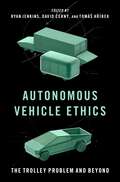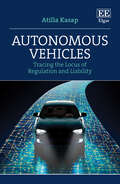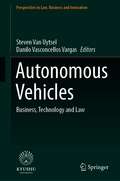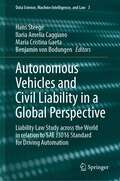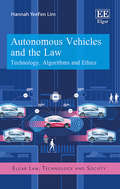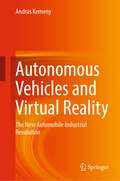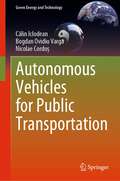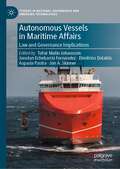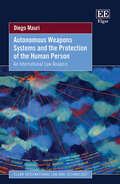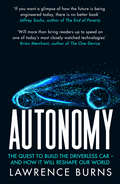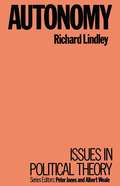- Table View
- List View
Autonomous Vehicle Ethics: The Trolley Problem and Beyond
"A runaway trolley is speeding down a track" So begins what is perhaps the most fecund thought experiment of the past several decades since its invention by Philippa Foot. Since then, moral philosophers have applied the "trolley problem" as a thought experiment to study many different ethical conflicts - and chief among them is the programming of autonomous vehicles. Nowadays, however, very few philosophers accept that the trolley problem is a perfect analogy for driverless cars or that the situations autonomous vehicles face will resemble the forced choice of the unlucky bystander in the original thought experiment. This book represents a substantial and purposeful effort to move the academic discussion beyond the trolley problem to the broader ethical, legal, and social implications that autonomous vehicles present. There are still urgent questions waiting to be addressed, for example: how AVs might interact with human drivers in mixed or "hybrid" traffic environments; how AVs might reshape our urban landscapes; what unique security or privacy concerns are raised by AVs as connected devices in the "Internet of Things"; how the benefits and burdens of this new technology, including mobility, traffic congestion, and pollution, will be distributed throughout society; and more. An attempt to map the landscape of these next-generation questions and to suggest preliminary answers, this volume draws on the disciplines of philosophy, sociology, economics, urban planning and transportation engineering, business ethics and more, and represents a global range of perspectives.
Autonomous Vehicle Navigation: From Behavioral to Hybrid Multi-Controller Architectures
by Lounis AdouaneImprove the Safety, Flexibility, and Reliability of Autonomous Navigation in Complex EnvironmentsAutonomous Vehicle Navigation: From Behavioral to Hybrid Multi-Controller Architectures explores the use of multi-controller architectures in fully autonomous robot navigation-even in highly dynamic and cluttered environments. Accessible to researchers
Autonomous Vehicle Navigation: From Behavioral to Hybrid Multi-Controller Architectures
by Lounis AdouaneImprove the Safety, Flexibility, and Reliability of Autonomous Navigation in Complex EnvironmentsAutonomous Vehicle Navigation: From Behavioral to Hybrid Multi-Controller Architectures explores the use of multi-controller architectures in fully autonomous robot navigation-even in highly dynamic and cluttered environments. Accessible to researchers
Autonomous Vehicle Technology: Global Exploration and Chinese Practice (Unmanned System Technologies)
by Mingfang DuThe subject of this book is artificial intelligence (AI), introducing the fast road sensing algorithm and system based on image pattern recognition for unmanned vehicle, especially for traffic sign recognition and complex road recognition. With rich figures and credible data, this book systematically and comprehensively describes the core technology and industrialization focus of today's unmanned vehicle system, which can be used as a reference for R & D Engineers and industrialization practitioners of unmanned vehicle, and it can also be used as a teaching material for higher grades and postgraduates in colleges and universities.
Autonomous Vehicles: Tracing the Locus of Regulation and Liability
by Atilla KasapDelving deep into the emerging international and federal statutory and legislative developments surrounding Autonomous Vehicle (AV) technologies, Atilla Kasap assesses whether current motor vehicle regulations, liability law and the liability insurance system are fit for purpose today and in the future.Making a significant and novel contribution to the field, this cutting-edge book comprehensively surveys the promises offered by AVs, including radically reduced road incidents, and economic, environmental and societal benefits, alongside the significant regulatory and liability problems the technology faces. Kasap finds that, as AVs are one of the most significant and profound technological advances of the 21st century, relying on machine learning and pattern recognition systems to function, the current liability regime surrounding them requires a rethinking. Critically analysing the tort liability of AVs, chapters deconstruct and reconstruct a tort law regime for AVs, ultimately solving how policymakers should approach the challenges faced in regulating and enacting AV legislation.Interdisciplinary in approach, it will prove invaluable to students and scholars of computer science and law, particularly those studying AI and robotics law, and those interested in the regulation and governance of AV technology. It also offers vital tools for policymakers seeking concrete principles on which to define potential laws and regulations for AV technology.
Autonomous Vehicles: Business, Technology and Law (Perspectives in Law, Business and Innovation)
by Steven Van Uytsel Danilo Vasconcellos VargasThis edited book aims to address challenges facing the deployment of autonomous vehicles. Autonomous vehicles were predicted to hit the road by 2017. Even though a high degree of automation may have been achieved, vehicles that can drive autonomously under all circumstances are not yet commercially available, and the predictions have been adjusted. Now, experts even say that we are still decades away from fully autonomous vehicles. In this volume, the authors form a multidisciplinary team of experts to discuss some of the reasons behind this delay. The focus is on three areas: business, technology, and law. The authors discuss how the traditional car manufacturers have to devote numerous resources to the development of a new business model, in which the sole manufacturing of vehicles may no longer be sufficient. In addition, the book seeks to introduce how technological challenges are creating a shift toward connected autonomous vehicles. Further, it provides insight into how regulators are responding to the insufficiently tested technology and how lawyers try to answer the liability question for accidents with these autonomous vehicles.
Autonomous Vehicles and Civil Liability in a Global Perspective: Liability Law Study across the World in relation to SAE J3016 Standard for Driving Automation (Data Science, Machine Intelligence, and Law #3)
by Hans Steege Ilaria Amelia Caggiano Maria Cristina Gaeta Benjamin Von BodungenIn the automotive sector, digitalisation, connectivity and automation are rapidly expanding. In tomorrow’s vehicles, human beings will merely be passengers – which raises a host of complex legal issues regarding accidents involving self-driving vehicles. This book is the first to offer a comprehensive, global overview of civil liability regimes for all levels of vehicle automation in jurisdictions that represent some of the most important markets for the automotive industry. After a technical introduction to how self-driving cars work, the individual chapters analyse the liability for driving automation at SAE J3016 levels 0 through 5 from a country-specific perspective. All chapters were written by experts in the field and follow a uniform legal structure. Hence, the book offers an essential comparative analysis of similarities and differences in the jurisdictions examined, while also providing suggestions for future legislative changes at the national and international level. The book is not only relevant for legal scholars and practitioners but will also be of particular interest to anyone involved in the design, manufacture, distribution and operation of self-driving vehicles.
Autonomous Vehicles and Future Mobility
by Pierluigi Coppola Domokos Esztergár-KissAutonomous Vehicles and Future Mobility presents novel methods for examining the long-term effects on individuals, society, and on the environment for a wide range of forthcoming transport scenarios, such as self-driving vehicles, workplace mobility plans, demand responsive transport analysis, mobility as a service, multi-source transport data provision, and door-to-door mobility. With the development and realization of new mobility options comes change in long-term travel behavior and transport policy. This book addresses these impacts, considering such key areas as the attitude of users towards new services, the consequences of introducing new mobility forms, the impacts of changing work related trips, and more. By examining and contextualizing innovative transport solutions in this rapidly evolving field, the book provides insights into the current implementation of these potentially sustainable solutions. It will serve as a resource of general guidelines and best practices for researchers, professionals and policymakers. - Covers hot topics, including travel behavior change, autonomous vehicle impacts, intelligent solutions, mobility planning, mobility as a service, sustainable solutions, and more - Examines up-to-date models and applications using novel technologies - Contains contributions from leading scholars around the globe - Includes case studies with the latest research results
Autonomous Vehicles and Systems: A Technological and Societal Perspective (River Publishers Series in Automation, Control and Robotics)
by Ishwar K. SethiThis book captures multidisciplinary research encompassing various facets of autonomous vehicle systems (AVS) research and developments. The AVS field is rapidly moving towards realization with numerous advances continually reported. The contributions to this field come from widely varying branches of knowledge, making it a truly multidisciplinary area of research and development. The topics covered in the book include: AI and deep learning for AVS Autonomous steering through deep neural networks Adversarial attacks and defenses on autonomous vehicles Gesture recognition for vehicle control Multi-sensor fusion in autonomous vehicles Teleoperation technologies for AVS Simulation and game theoretic decision making for AVS Path following control system design for AVS Hybrid cloud and edge solutions for AVS Ethics of AVS
Autonomous Vehicles and Systems: A Technological and Societal Perspective (River Publishers Series in Automation, Control and Robotics)
by Ishwar K. SethiThis book captures multidisciplinary research encompassing various facets of autonomous vehicle systems (AVS) research and developments. The AVS field is rapidly moving towards realization with numerous advances continually reported. The contributions to this field come from widely varying branches of knowledge, making it a truly multidisciplinary area of research and development. The topics covered in the book include: AI and deep learning for AVS Autonomous steering through deep neural networks Adversarial attacks and defenses on autonomous vehicles Gesture recognition for vehicle control Multi-sensor fusion in autonomous vehicles Teleoperation technologies for AVS Simulation and game theoretic decision making for AVS Path following control system design for AVS Hybrid cloud and edge solutions for AVS Ethics of AVS
Autonomous Vehicles and the Law: How Each Field is Shaping the Other (Synthesis Lectures on Advances in Automotive Technology)
by A. Buke HizirogluDisciplines can no longer be isolated. Technology has rapidly evolved to the point that driverless vehicles have truly become a reality and are not something out of a futuristic exhibition from the 1950s. However, engineers and researchers working on the development of autonomous vehicles cannot ignore the policy implications and policymakers as well as attorneys cannot ignore the technology. We are at a point where cross-disciplinary collaboration is vital in order to produce a technology that will immensely benefit society. This is the goal of this book: to educate autonomous vehicle developers on legal theory at the most basic level. Both policymakers and lawyers may also find the book helpful in gaining a basic understanding of the technology the developers are working on. The 2nd edition will dive further into cyber security as well as provide legal hypotheticals to give a perspective to engineers or others working in the field. Additionally, it will focus more on liability,which has had some changes recently.
Autonomous Vehicles and the Law: How Each Field is Shaping the Other (Synthesis Lectures on Advances in Automotive Technology)
by Ayse Buke HizirogluDisciplines can no longer be isolated. Technology has rapidly evolved to the point that driverless vehicles have truly become a reality and are not something out of a futuristic exhibition from the 1950s. However, engineers and researchers working on the development of autonomous vehicles cannot ignore the policy implications and policymakers as well as attorneys cannot ignore the technology. We are at a point where cross-disciplinary collaboration is vital in order to produce a technology that will immensely benefit society. This is the goal of this book: to educate autonomous vehicle developers on legal theory at the most basic level. Both policymakers and lawyers may also find the book helpful in gaining a basic understanding of the technology the developers are working on.
Autonomous Vehicles and the Law: Technology, Algorithms and Ethics (Elgar Law, Technology and Society series)
by Hannah Y. LimAutonomous vehicles have attracted a great deal of attention in the media, however there are some inconsistencies between the perception of autonomous vehicles’ capabilities and their actual functions. This book provides an accessible explanation of how autonomous vehicles function, including comprehensive explanations of the artificial intelligence (AI) involved, software and hardware, and suggests appropriate regulatory responses to the existing and emerging technology. Hannah YeeFen Lim explores the current capabilities of autonomous vehicles and importantly, highlights their inherent limitations and expounds the machine learning and algorithm pitfalls. Lim provides a concise and easy to follow overview of the technology behind autonomous vehicles which encompasses hardware and software aspects, including machine learning algorithms. Having laid the technical foundation, the following chapters assess the current legal standards in negligence law that are applicable to autonomous vehicles taking into account the current technical limitations of the vehicles. Lim concludes by exploring the ethical issues associated with autonomous vehicles and proposes appropriate regulatory approaches. This book will be of great value to policy makers seeking a deeper understanding of the technology behind autonomous vehicles and the relevant legal landscape in order to inform and guide the development of policies, laws and regulations. Legal practitioners will benefit from the discussion of recent use cases and applicable negligence law. Legal scholars researching artificial intelligence will also find the author’s easy to understand technical explanations and discourse on ethical considerations invaluable.
Autonomous Vehicles and Virtual Reality: The New Automobile Industrial Revolution
by Andras KemenyThis book concisely describes the technologies, human perception, and cognition issues relevant to autonomous vehicles. It also gives an insight in the changes bring about our future everyday lives.Autonomous vehicles are the future of the automobile industry. Automated driving (AD), also called self-driving, raises however several multiple questions, among them those of user safety and acceptation. Comprehensive HMI system design, with windshield display technics, will be necessary to deal with driving task delegations, bringing the use of VR or augmented reality (AR) technologies. In addition, the use of VR for all the vehicle interiors will progressively be proposed for entertainment, online business activities and for modified visual motion perception to alleviate car sickness, a form of motion sickness. Indeed, car sickness is already well known for many passengers, especially when reading or operating smartphones or other display devices. It is called to increase significantly with the introduction of autonomous vehicles where all users will be for long periods in various sitting positions. These two new trends, AD and VR, are already modifying our relationship with the world and the society. All together, they will change our way of life forever. The book will be of interest to professionals in the auto industry, researchers in automotive engineering and computer science and all those interested in the future of transport.
Autonomous Vehicles for Public Transportation (Green Energy and Technology)
by Călin Iclodean Bogdan Ovidiu Varga Nicolae CordoșThis book presents an interdisciplinary approach to autonomous driving technology design and development. It discusses a methodology of simulation that allows specialists to evaluate autonomous vehicle sensors functionality and integration, energy flow, efficiency, range, and service under public transport.The design, calibration, and physical model behind each autonomous vehicle sensor and component is explained. For each specific vehicle, the powertrain is analyzed, and output results are presented through the use of specific automotive industrial software (IPG CarMaker).The book gives the reader a clear perspective of the key factors influencing the global functionality of autonomous shuttle buses with respect to both their inner components the variable exterior factors and an exhaustive legal perspective in relation of their presence on public roads.
Autonomous Versus Domestic Concepts under the New York Convention
by Franco Ferrari Friedrich RosenfeldInternational Arbitration Law Library # 61 The 1958 New York Convention is universally acclaimed as one of the most important instruments on international commercial arbitration. Although the Convention ensures that contracting States cannot justify failure to comply with their treaty obligations by reference to domestic law, the courts of different contracting States apply the Convention differently. This diverging case law arises from uncertainty as to whether certain concepts employed in the Convention must be construed autonomously or in light of domestic law. This incomparable analysis of the New York Convention as an instrument of uniform law presents insightful contributions by some of the world’s most distinguished academics and practitioners in the field of arbitration and is sure to significantly contribute to arbitral practice and jurisprudence in the Convention’s more than 160 contracting States. With extensive reference to case law from major arbitration hubs, the contributors examine the Convention with the aim of identifying the boundaries between autonomous and domestic concepts. Key elements covered include the following: the role of private international law under the Convention; notions of arbitrability and arbitral award; procedures for the enforcement of awards; nullity, invalidity, and conflict of laws under Articles II(3) and V(1)(a); the incapacity defence under Article V(1)(a); deviations from procedure; autonomous boundaries as to what falls under the issue of scope; and public policy under the Convention. The first and only resource of its kind, this book provides an invaluable clarification of the extent to which the Convention leaves room for the application of domestic law and, if so, how to determine which particular domestic law may be applicable. It will be welcomed by counsel, judges, arbitrators, and academics throughout the States that have signed the New York Convention.
Autonomous Vessels in Maritime Affairs: Law and Governance Implications (Studies in National Governance and Emerging Technologies)
by Tafsir Matin Johansson Jonatan Echebarria Fernández Dimitrios Dalaklis Aspasia Pastra Jon A. SkinnerThis first-of-its-kind incisive and interdisciplinary volume spears through law and governance implications in relation to maritime autonomous surface ships (MASS). The book focuses on a wide array of timely, topical and thorny issues under eight distinct parts: setting the scene; naval warfare and security; safety, seaworthiness and techno-regulatory assessments; global environmental change; autonomous passenger transportation; liability and insurance; selected national and regional developments; and tying the threads. Thus, the main themes will stress on topics including evolution, environment, safety and security, society, insurance, liability, human element, design solutions and procedures, and selected national case studies. At the outset, the book commences with an insight into the role of innovation-diplomacy as the driving force that could expedite the transition from autonomation to autonomy, and a commentary from the Chair of IMO’s MASS. After navigating through the complex law and governance landscape, the book concludes with a chapter that captures the essence of the paradigm shift and ties all critical findings for further consideration.Chapter 11 and Chapter 18 are available open access under a Creative Commons Attribution 4.0 International License via link.springer.com.
Autonomous Weapons Systems and the Protection of the Human Person: An International Law Analysis (Elgar International Law and Technology series)
by Diego MauriProviding a much-needed study of the weapons paradox in the case of autonomous weapons, this book is a detailed and comprehensive account of the current debate over the use of autonomous weapons – should some form of regulation be applied or a total ban be enforced? How can compliance with existing rules be ensured? Can responsibility be properly allocated? To what extent do concepts such as ‘human dignity’ and ‘humanity’ provide legal guidance in coping with technology? This book tackles these momentous challenges and strives to provide sound answers by elaborating on international law and proposing normative solutions for current and future human–machine interactions in this critical field. Diego Mauri expertly explains the complex new technological research involved in autonomous weaponry, with particular focus on technological developments that have elicited intense debates among diplomats, military experts, scientists, philosophers, and international lawyers. Providing innovative and original discussion of the effective protection of the human person in international law, this book will be welcomed by legal scholars, human rights lawyers, and researchers concerned with the relationship between international law and technology.
Autonomous Weapons Systems and the Responsibility of States: Challenges and Possibilities
by Lutiana Valadares Fernandes BarbosaThis book reviews whether the existing framework in place can effectively address breaches in the context of Autonomous Weapons Systems (AWS). The work endeavors to map out the main gaps and some possible approaches to address them. Part I sets the ground. First, it provides a concept of AWS. Next, it discusses the accountability gap AWS generate and shows how the international community has put far more emphasis on individual responsibility rather than state responsibility. Part II analyzes the challenges AWS pose to the regime governing state responsibility under international law, as codified in the Draft Articles on State Responsibility (ARSIWA). In this regard, it discusses attribution, breach of an international obligation, tempus comissi delicti, multiple states involved in a breach, force majeure, assurance of non-repetition, issues related to damage, the human-machine interaction and its impacts on state´s responsibility, responsibility for not using AWS, weapons review and the duty of due diligence. Part III summarizes the challenges discussed in part II in thirteen issues of concern and presents possible paths de lege ferenda to address each of those issues, mainly a paradigm shift in attribution and strict liability, among seven other more specific proposals. The conclusion reached is that the current regime on the international responsibility of states is insufficient to deal with the new challenges AWS pose. De lege ferenda, the book argues for following the paths suggested in part III. It also reflects on parts II and III's findings and how many of AWS's challenges to state´s responsibility apply to other autonomous devices. Therefore, through the case study of AWS, this work also opens the broader discussion of the gaps in the international responsibility of states regarding autonomous device misdoings.
Autonomous Weapons Systems and the Responsibility of States: Challenges and Possibilities
by Lutiana Valadares Fernandes BarbosaThis book reviews whether the existing framework in place can effectively address breaches in the context of Autonomous Weapons Systems (AWS). The work endeavors to map out the main gaps and some possible approaches to address them. Part I sets the ground. First, it provides a concept of AWS. Next, it discusses the accountability gap AWS generate and shows how the international community has put far more emphasis on individual responsibility rather than state responsibility. Part II analyzes the challenges AWS pose to the regime governing state responsibility under international law, as codified in the Draft Articles on State Responsibility (ARSIWA). In this regard, it discusses attribution, breach of an international obligation, tempus comissi delicti, multiple states involved in a breach, force majeure, assurance of non-repetition, issues related to damage, the human-machine interaction and its impacts on state´s responsibility, responsibility for not using AWS, weapons review and the duty of due diligence. Part III summarizes the challenges discussed in part II in thirteen issues of concern and presents possible paths de lege ferenda to address each of those issues, mainly a paradigm shift in attribution and strict liability, among seven other more specific proposals. The conclusion reached is that the current regime on the international responsibility of states is insufficient to deal with the new challenges AWS pose. De lege ferenda, the book argues for following the paths suggested in part III. It also reflects on parts II and III's findings and how many of AWS's challenges to state´s responsibility apply to other autonomous devices. Therefore, through the case study of AWS, this work also opens the broader discussion of the gaps in the international responsibility of states regarding autonomous device misdoings.
The Autonomous Web (Studies in Big Data #101)
by Herwig Unger Mario KubekThis book initiates a transformation of the Web into a self-managing, autonomous information system to challenge today’s all-embracing role of big search engines as centralized information managers. In the last decades, the World Wide Web became the biggest source for all kinds of information needed. After a short review of the state of the art, a Web-based system is presented for the first time, which employs all its instances equally to provide, consume, and process information uniformly and consistently. In order to build such an efficient, decentralized, and fully integrated information space with all its needed functionalities, a set of diverse algorithms is introduced. These novel mechanisms for load balancing, routing, clustering, document classification, but also time-dependent information management pertain to almost all system levels. Finally, three different approaches to decentralized Web search are discussed that represent the backbone of the new autonomous Web.
Autonomy: The Quest To Build The Driverless Car - And How It Will Reshape Our World
by Lawrence Burns’A fascinating hybrid. Part freewheeling history of the rise of the modern autonomous vehicle, part intimate memoir from an insider who was on the front lines for much of that history, Autonomy will more than bring readers up to speed on one of today’s most closely watched technologies’ Brian Merchant, author of The One Device
Autonomy: Capitalism, Class and Politics
by David EdenAutonomy: Capital, Class and Politics explores and critiques one of the most dynamic terrains of political theory, sometimes referred to as 'Autonomist Marxism' or post-Operaismo. This theory shot to prominence with the publication of Empire by Hardt and Negri and has been associated with cutting edge developments in political and cultural practice; yet there exists no work that critically examines it in its contemporary breadth. Taking three divergent manifestations of Autonomist Marxism found in the works of Antonio Negri and Paulo Virno, the Midnight Notes Collective and John Holloway, David Eden examines how each approach questions the nature of class and contemporary capitalism and how they extrapolate politics. Not only is such juxtaposition both fruitful and unprecedented but Eden then constructs critiques of each approach and draws out deeper common concerns. Suggesting a novel rethinking of emancipatory praxis, this book provides a much needed insight into the current tensions and clashes within society and politics.
Autonomy: Capitalism, Class and Politics
by David EdenAutonomy: Capital, Class and Politics explores and critiques one of the most dynamic terrains of political theory, sometimes referred to as 'Autonomist Marxism' or post-Operaismo. This theory shot to prominence with the publication of Empire by Hardt and Negri and has been associated with cutting edge developments in political and cultural practice; yet there exists no work that critically examines it in its contemporary breadth. Taking three divergent manifestations of Autonomist Marxism found in the works of Antonio Negri and Paulo Virno, the Midnight Notes Collective and John Holloway, David Eden examines how each approach questions the nature of class and contemporary capitalism and how they extrapolate politics. Not only is such juxtaposition both fruitful and unprecedented but Eden then constructs critiques of each approach and draws out deeper common concerns. Suggesting a novel rethinking of emancipatory praxis, this book provides a much needed insight into the current tensions and clashes within society and politics.
